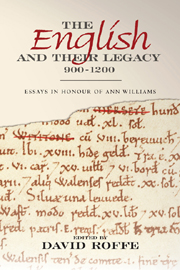Book contents
- Frontmatter
- Contents
- Figures and Tables
- Dedication
- Preface
- Contributors
- Abbreviations
- Ann Williams: a Personal Appreciation
- Life-writing and the Anglo-Saxons
- Meet the Swarts: Tracing a Thegnly Family in Late Anglo-Saxon England
- The Moneyers of Kent in the Long Eleventh Century
- Master Wace: a cross-Channel Prosopographer for the Twelfth Century?
- From Minster to Manor: the Early History of Bredon
- Eadulfingtun, Edmonton, and their Contexts
- The Family of Wulfric Spott: an Anglo-Saxon Mercian Marcher Dynasty?
- The Burial of King Æthelred the Unready at St Paul's
- Eustace II of Boulogne, the Crises of 1051–2 and the English Coinage
- Through the Eye of the Needle: Stigand, the Bayeux Tapestry and the Beginnings of the Historia Anglorum
- Robert of Torigni and the Historia Anglorum
- Invoking Earl Waltheof
- Hidden Lives: English Lords in post-Conquest Lincolnshire and Beyond
- Lordship and Lunching: Interpretations of Eating and Food in the Anglo-Norman World, 1050–1200, with Reference to the Bayeux Tapestry
- The Exchequer Cloth, c. 1176–1832: the Calculator, the Game of Chess, and the Process of Photozincography
- Ann Williams: a Bibliography 1969–2011
- Index
- Tabula Gratuloria
Hidden Lives: English Lords in post-Conquest Lincolnshire and Beyond
Published online by Cambridge University Press: 05 April 2013
- Frontmatter
- Contents
- Figures and Tables
- Dedication
- Preface
- Contributors
- Abbreviations
- Ann Williams: a Personal Appreciation
- Life-writing and the Anglo-Saxons
- Meet the Swarts: Tracing a Thegnly Family in Late Anglo-Saxon England
- The Moneyers of Kent in the Long Eleventh Century
- Master Wace: a cross-Channel Prosopographer for the Twelfth Century?
- From Minster to Manor: the Early History of Bredon
- Eadulfingtun, Edmonton, and their Contexts
- The Family of Wulfric Spott: an Anglo-Saxon Mercian Marcher Dynasty?
- The Burial of King Æthelred the Unready at St Paul's
- Eustace II of Boulogne, the Crises of 1051–2 and the English Coinage
- Through the Eye of the Needle: Stigand, the Bayeux Tapestry and the Beginnings of the Historia Anglorum
- Robert of Torigni and the Historia Anglorum
- Invoking Earl Waltheof
- Hidden Lives: English Lords in post-Conquest Lincolnshire and Beyond
- Lordship and Lunching: Interpretations of Eating and Food in the Anglo-Norman World, 1050–1200, with Reference to the Bayeux Tapestry
- The Exchequer Cloth, c. 1176–1832: the Calculator, the Game of Chess, and the Process of Photozincography
- Ann Williams: a Bibliography 1969–2011
- Index
- Tabula Gratuloria
Summary
1066 is justifiably the most famous date in English history. England did not become Norman with the death of King Harold on 14 October in that year: the Norman Conquest and settlement was a protracted process that continued into the 1080s and beyond. Nevertheless, the Domesday inquest of 1086 affords a vantage point from which it can be seen that England had changed radically. An English aristocracy had been superseded by a predominantly Norman one. Traditionally, that transfer of power has been seen in essentially military terms. The imposition of ‘the Norman yoke’ was by right of conquest. and the feudalism that William the Conqueror introduced was a revolution in tenure. Recent analyses have been more nuanced. The conquest undoubtedly saw episodes of unbridled acquisitiveness, especially in the early days. But the settlement was essentially an ordered process. It was English laws and English customs that underpinned Norman tenure in 1086.
Ann Williams’ work on the English and the Norman Conquest has been central to this reassessment. It is to her that we owe a much greater understanding of the importance of Englishmen – the term is here used of all those with roots in England – to a successful Norman settlement. The evidence is often fragmentary, but, taken together, overwhelming. A conservative estimate puts the total number of English landowners in 1086, as recorded in Domesday Book, at 1000 or so individuals holding some 6% of the recorded land valued at 4.2% of the national income.
- Type
- Chapter
- Information
- The English and their Legacy, 900–1200Essays in Honour of Ann Williams, pp. 205 - 228Publisher: Boydell & BrewerPrint publication year: 2012

